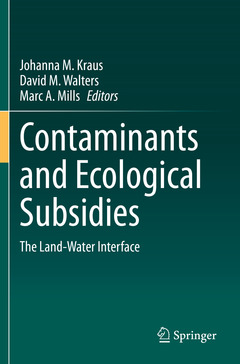Contaminants and Ecological Subsidies, 1st ed. 2020 The Land-Water Interface
Coordonnateurs : Kraus Johanna M., Walters David M., Mills Marc A.

David M. Walters, Ph.D. is a Research Ecologist with the U.S. Geological Survey (USGS) Columbia Environmental Research Center. His research focuses on the effects of human stressors on the form, function, and structure of aquatic and riparian ecosystems with an emphasis on food web dynamics and contaminants. He began his career at the U.S. Environmental Protection Agency National Exposure Research Laboratory in 2002 before joining the USGS in 2008. His publications have addressed the impacts of contaminants, land use and climate change, invasive species, and hydrologic alteration on aquatic and riparian organisms and are geared toward furthering the conservation and restoration of these valued ecosystems. He received an M.S. and Ph.D. from the Odum School of Ecology at the University of Georgia.
Marc A. Mills, Ph.D. is an Environmental Engineer at the U.S. EPA’s Office of Research and Development and is a principal investigator for projects characterizing the occurrence, transport, and fate of contaminants of emerging concern (CECs) and legacy contaminants in the environment and the management of contaminat
Overviews the concepts and principles governing the effects of aquatic contaminants on terrestrial food webs and explores the relationship between exposures and ecological subsidies
Provides extensive coverage of how environmental stressors interact with contaminants to shape aquatic-terrestrial linkages
Explores management implications and applications for predictive understanding of how aquatic contaminants impact terrestrial consumers, including remedy effectiveness, risk assessment, landscape scale predictions, loss of food to secondary consumers
Date de parution : 10-2021
Ouvrage de 383 p.
15.5x23.5 cm
Date de parution : 10-2020
Ouvrage de 383 p.
15.5x23.5 cm



